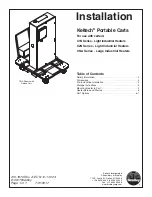
Feniks FUTURE Instruction Manual, No.
033-02-200
edition
IA
, 2012, page
4
of
36
AIR-POL Sp. z o.o.
– 05-120 Legionowo, ul. Olszankowa 52, www.air-pol.com.pl
tel.: (+4822) 774 0711, (+4822) 784 1595, (+4822) 774 4832, fax (+4822) 784 9640, @: [email protected]
SECTION I
TECHNICAL SPECIFICATION
1.
INTENDED PURPOSE
The Feniks FUTURE system was designed for skydivers skilled in freefall or attending an AFF course. The Feniks FUTURE
system is the perfect choice for all skydiving sport disciplines. The system can be used with a variety of canopies, with the
ultimate choice dependent on the intended use (client expectations). The system’s ergonomics ensure amazing comfort, do
not impede mobility, and allow full freedom of movement. The harness design prevents the container from shifting on the
skydiver’s back.
The entirely back-mounted Feniks system consists of a reserve parachute container, a main parachute container, and a
container-integrated harness for a single skydiver.
The main parachute container has been adapted for collapsible pilot chute hand deployment, with the pilot chute placed in an
external bottom-of-container pouch.
In case of main parachute malfunction, the skydiver can disconnect it from the harness with the use of a three-ring release
system, with the cutaway handle placed under the chest strap on the right main harness strap.
The reserve canopy container is closed with a single closing pin, and fitted with a deployment handle placed on the left main
harness strap. It is fitted with a spring-loaded pilot chute placed entirely within the container, and a reserve canopy free-bag
with an integrated connecting tape allowing use with the “Smart Loop” system. The container allows the assembly of an
Automatic Activation Device (AAD) initiating the reserve canopy deployment process. The standard design of the
harness/container includes a detachable RSL (Reserve Static Line) system, which deploys the reserve parachute
immediately upon main parachute release. As an option, the Feniks system may be fitted with an extra RSL system
component – the “
Smart Loop
”.
The “Smart Loop” design is based on the concept of shortening the time it takes for the reserve parachute free-bag to leave
the container upon main canopy cutaway. In the traditional RSL system, after the main parachute has been released, the
process of reserve parachute deployment is initiated by the container closing loop being pulled. This is where the RSL
system purpose ends, and the reserve parachute is pulled out by the spring-loaded pilot chute mounted within the container.
When coupled with the RSL system, not only will the “Smart Loop” open the reserve parachute container, but also pull the
reserve parachute out, unfold the suspensions lines, and release the reserve parachute free-bag from the canopy. The main
parachute canopy takes over as the deployment pilot chute, which – thanks to its significantly larger surface and the
generated resistance – shall significantly accelerate the speed of the reserve parachute deployment process. Should the
reserve parachute be deployed by the direct use of the deployment handle, the “Smart Loop” system is disconnected
automatically, and the reserve canopy is pulled out of the container by the spring-loaded pilot chute.





































